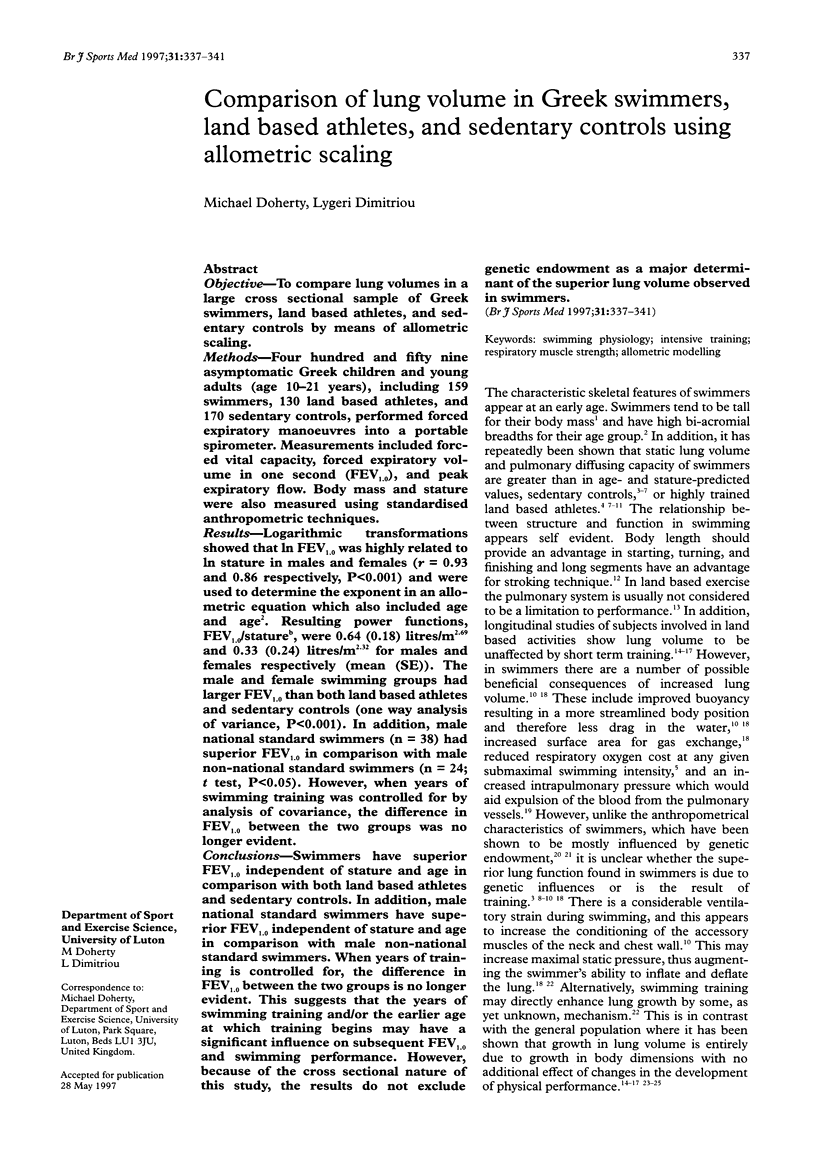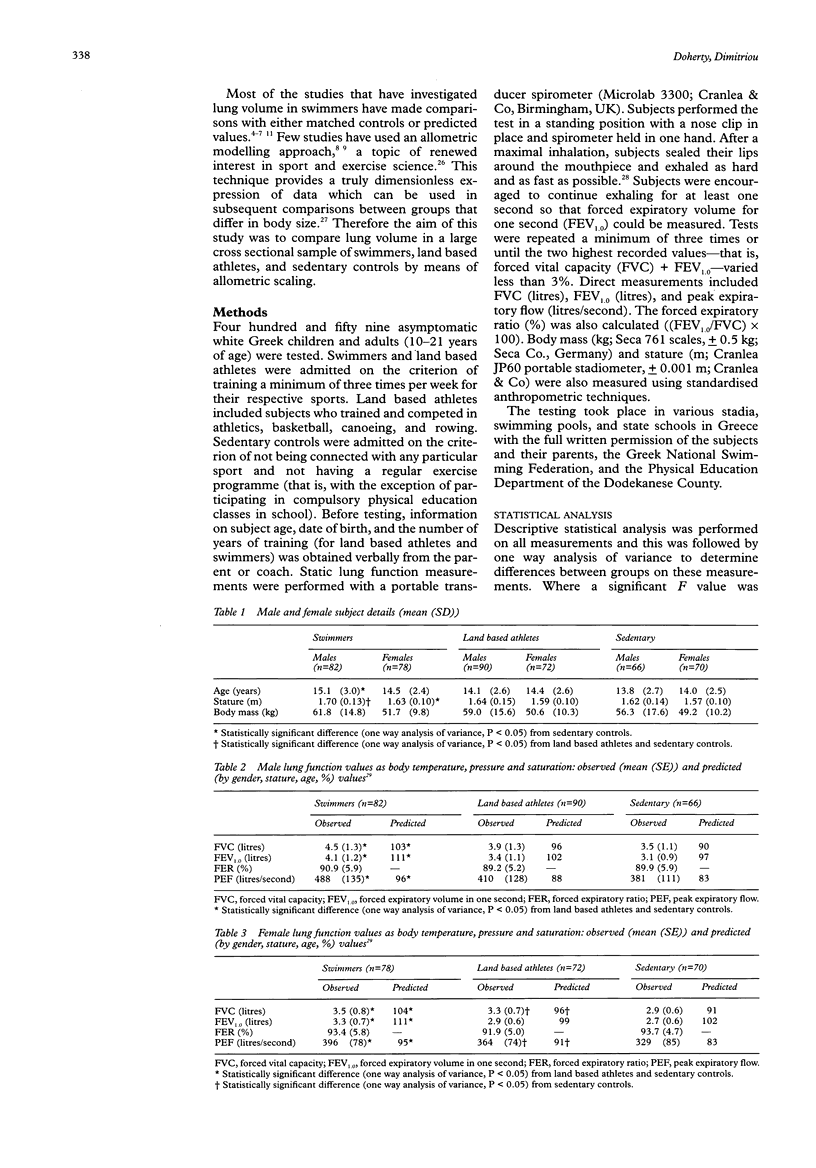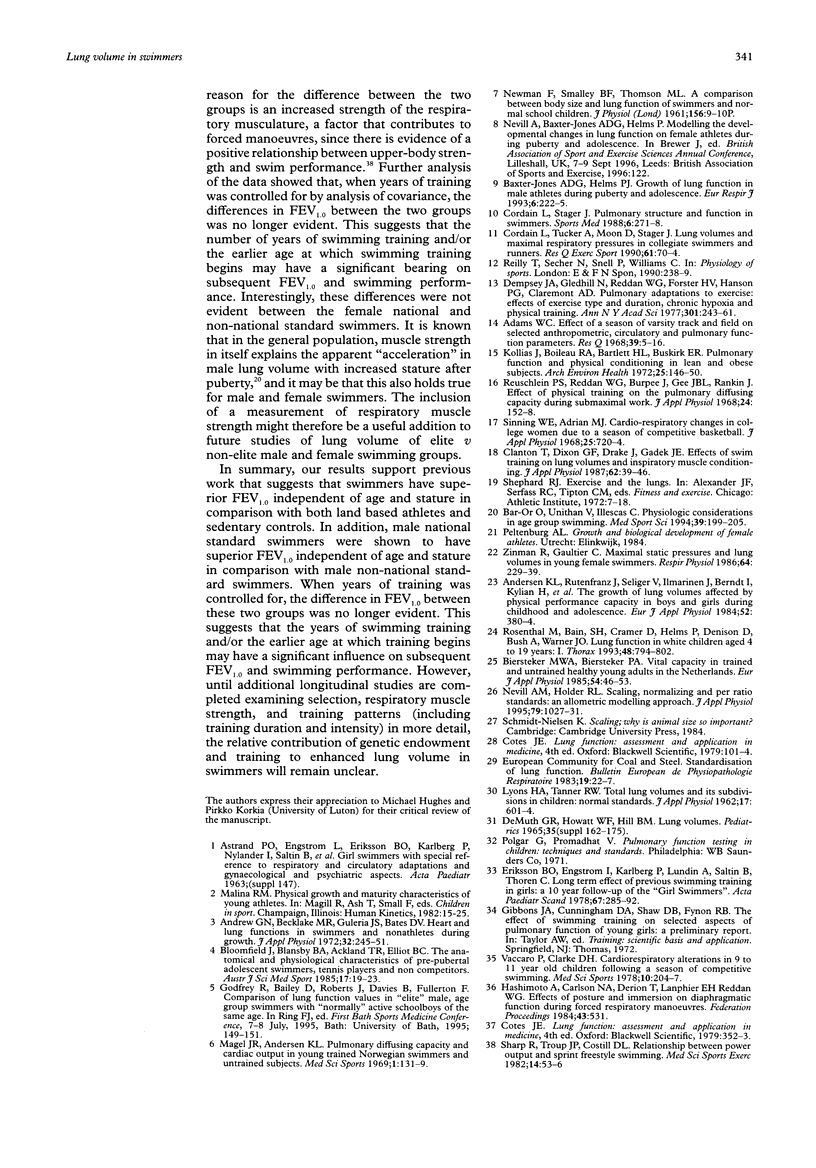Abstract
OBJECTIVE: To compare lung volumes in a large cross sectional sample of Greek swimmers, land based athletes, and sedentary controls by means of allometric scaling. METHODS: Four hundred and fifty nine asymptomatic Greek children and young adults (age 10-21 years), including 159 swimmers, 130 land based athletes, and 170 sedentary controls, performed forced expiratory manoeuvres into a portable spirometer. Measurements included forced vital capacity, forced expiratory volume in one second (FEV1.0), and peak expiratory flow. Body mass and stature were also measured using standardised anthropometric techniques. RESULTS: Logarithmic transformations showed that in FEV1.0 was highly related to in stature in males and females (r = 0.93 and 0.86 respectively, P < 0.001) and were used to determine the exponent in an allometric equation which also included age and age. Resulting power functions, FEV1.0/stature, were 0.64 (0.18) litres/m2.69 and 0.33 (0.24) litres/m2.32 for males and females respectively (mean (SE)). The male and female swimming groups had larger FEV1.0 than both land based athletes and sedentary controls (one way analysis of variance, P < 0.001). In addition, male national standard swimmers (n = 38) had superior FEV1.0 in comparison with male non-national standard swimmers (n = 24; t test, P < 0.05). However, when years of swimming training was controlled for by analysis of covariance, the difference in FEV1.0 between the two groups was no longer evident. CONCLUSIONS: Swimmers have superior FEV1.0 independent of stature and age in comparison with both land based athletes and sedentary controls. In addition, male national standard swimmers have superior FEV1.0 independent of stature and age in comparison with male non-national standard swimmers. When years of training is controlled for, the difference in FEV1.0 between the two groups is no longer evident. This suggests that the years of swimming training and/or the earlier age at which training begins may have a significant influence on subsequent FEV1.0 and swimming performance. However, because of the cross sectional nature of this study, the results do not exclude genetic endowment as a major determinant of the superior lung volume observed in swimmers.
Full text
PDF




Selected References
These references are in PubMed. This may not be the complete list of references from this article.
- Adams W. C. Effect of a season of varsity track and field on selected anthropometric, circulatory, and pulmonary function parameters. Res Q. 1968 Mar;39(1):5–15. [PubMed] [Google Scholar]
- Andersen K. L., Rutenfranz J., Seliger V., Ilmarinen J., Berndt I., Kylian H., Ruppel M. The growth of lung volumes affected by physical performance capacity in boys and girls during childhood and adolescence. Eur J Appl Physiol Occup Physiol. 1984;52(4):380–384. doi: 10.1007/BF00943367. [DOI] [PubMed] [Google Scholar]
- Andrew G. M., Becklake M. R., Guleria J. S., Bates D. V. Heart and lung functions in swimmers and nonathletes during growth. J Appl Physiol. 1972 Feb;32(2):245–251. doi: 10.1152/jappl.1972.32.2.245. [DOI] [PubMed] [Google Scholar]
- Biersteker M. W., Biersteker P. A. Vital capacity in trained and untrained healthy young adults in the Netherlands. Eur J Appl Physiol Occup Physiol. 1985;54(1):46–53. doi: 10.1007/BF00426297. [DOI] [PubMed] [Google Scholar]
- Clanton T. L., Dixon G. F., Drake J., Gadek J. E. Effects of swim training on lung volumes and inspiratory muscle conditioning. J Appl Physiol (1985) 1987 Jan;62(1):39–46. doi: 10.1152/jappl.1987.62.1.39. [DOI] [PubMed] [Google Scholar]
- Cordain L., Stager J. Pulmonary structure and function in swimmers. Sports Med. 1988 Nov;6(5):271–278. doi: 10.2165/00007256-198806050-00002. [DOI] [PubMed] [Google Scholar]
- Cordain L., Tucker A., Moon D., Stager J. M. Lung volumes and maximal respiratory pressures in collegiate swimmers and runners. Res Q Exerc Sport. 1990 Mar;61(1):70–74. doi: 10.1080/02701367.1990.10607479. [DOI] [PubMed] [Google Scholar]
- Dempsey J. A., Gledhill N., Reddan W. G., Forster H. V., Hanson P. G., Claremont A. D. Pulmonary adaptation to exercise: effects of exercise type and duration, chronic hypoxia and physical training. Ann N Y Acad Sci. 1977;301:243–261. doi: 10.1111/j.1749-6632.1977.tb38203.x. [DOI] [PubMed] [Google Scholar]
- Eriksson B. O., Engström I., Karlberg P., Lundin A., Saltin B., Thorén C. Long-term effect of previous swimtraining in girls. A 10-year follow-up of the "girl swimmers". Acta Paediatr Scand. 1978 May;67(3):285–292. doi: 10.1111/j.1651-2227.1978.tb16322.x. [DOI] [PubMed] [Google Scholar]
- Kollias J., Boileau R. A., Barlett H. L., Buskirk E. R. Pulmonary function and physical conditioning in lean and obese subjects. Arch Environ Health. 1972 Aug;25(2):146–150. doi: 10.1080/00039896.1972.10666151. [DOI] [PubMed] [Google Scholar]
- LYONS H. A., TANNER R. W. Total lung volume and its subdivisions in children: normal standards. J Appl Physiol. 1962 Jul;17:601–604. doi: 10.1152/jappl.1962.17.4.601. [DOI] [PubMed] [Google Scholar]
- Nevill A. M., Holder R. L. Scaling, normalizing, and per ratio standards: an allometric modeling approach. J Appl Physiol (1985) 1995 Sep;79(3):1027–1031. doi: 10.1152/jappl.1995.79.3.1027. [DOI] [PubMed] [Google Scholar]
- Reuschlein P. S., Reddan W. G., Burpee J., Gee J. B., Rankin J. Effect of physical training on the pulmonary diffusing capacity during submaximal work. J Appl Physiol. 1968 Feb;24(2):152–158. doi: 10.1152/jappl.1968.24.2.152. [DOI] [PubMed] [Google Scholar]
- Rosenthal M., Bain S. H., Cramer D., Helms P., Denison D., Bush A., Warner J. O. Lung function in white children aged 4 to 19 years: I--Spirometry. Thorax. 1993 Aug;48(8):794–802. doi: 10.1136/thx.48.8.794. [DOI] [PMC free article] [PubMed] [Google Scholar]
- Sinning W. E., Adrian M. J. Cardiorespiratory changes in college women due to a season of competitive basketball. J Appl Physiol. 1968 Dec;25(6):720–724. doi: 10.1152/jappl.1968.25.6.720. [DOI] [PubMed] [Google Scholar]
- Vaccaro P., Clarke D. H. Cardiorespiratory alterations in 9 to 11 years old children following a season of competitive swimming. Med Sci Sports. 1978 Fall;10(3):204–207. [PubMed] [Google Scholar]


